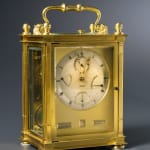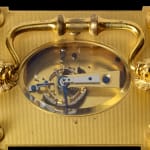Antoine Blondeau
Further images
Literature
Charles Allix, "Carriage Clocks, their History and Development", 1974, p. 39, pls. II/2 & 3, illustrating a carriage clock by Abraham-Louis Breguet no. 780, likewise with complicated movement and similarly shaped subsidiary dials and case, in the Ashmolean Museum, Oxford. Derek Roberts, "Carriage and other Travelling Clocks", 1993, p. 28, pls. 2-2 a, b & c, illustrating the latter clock. And p. 29, pl. 2-3, illustrating a Breguet et Fils carriage clock, sold 1831 to Marie-Christine de bourbon-Sicile, Queen of Spain, housed in a similar case of the same size, likewise with lion head handles. And p. 70, pl. 4-2, illustrating a very similar carriage clock of circa 1830, with almost identical shaped subsidiary dials within the main dial and calendar indications below as well as a very closely related case with Doric columns but a more ornate foliate frieze and base, signed on the backplate Blondeau Horologer Bte. du Roi, Rue de la Paix No. 19 and also numbered and signed on the silvered dial by Blondeau's successor Lézé no 910.
A very rare and fine quality Restauration gilt bronze grande sonnerie striking carriage clock with push repeat, calendar and equation of eight day duration by Antoile Blondeau à Paris, signed on the silvered engine turned dial Blondeau. The dial with Roman numerals and an outer minute indications with gilt brass Breguet-style hands for the hours and minutes, enclosing four subsidiary dials comprising a circular seconds dial below 12 o'clock, a fan shaped dial at 9 o'clock for the strike/silent regulation marked: Silen • Sonne, a demi-lune-shaped dial above 6 o'clock for the equation marked: 15/10/5/0/5/10/15 and a fan-shaped dial at 3 o'clock to indicate the state of wind marked: B Devt du Rest H, each with a blued steel pointer, with three apertures below the dial within the gilt engine turned dial mask respectively showing the days of the week, the dates of the month and names of the month. The movement with a bimetallic chronometer escapement, equation, advanced and retard, with grande sonnerie striking and push repeat via a knob on the top. The heavy multi-piece gilt bronze Breguet-style case with Doric fluted pilasters, glazed sides, back and front doors, with an oval glazed aperture on the top to view the escapement, surmounted by four ball finials and a scroll handle issuing from lion heads, the whole on plain bun feet
Paris, date circa 1825-30
Height with handle 17 cm, width 11 cm, depth 8.5 cm.
Close comparisons can be made with this magnificent carriage clock and that illustrated in Derek Roberts' book, ibid, p. 70, which likewise has four similarly arranged subsidiary dials within the main dial but instead of the present demi-lune equation dial there is a similarly shaped moon phase dial. What is particularly interesting is that the latter was signed on the backplate with Blondeau's name and address but the dial shows the name of Lézé, who presumably sold the clock after he had acquired Blondeau's thriving business. Derek Roberts notes that the handle of the latter clock bears the name of the duc de Vallombrosa, for whom the clock was presumably made and furthermore that it was possibly exhibited on Blondeau's stand at the Paris Universelle Exposition in 1827. If that was so then the duc de Vallombrosa's clock may well have been one described as 'une montre de voyage' of eight day duration, with calendar and moon phases and grande sonnerie striking.
Antoine Blondeau of 19 rue de la Paix in Paris was a much admired horloger-mécanicien who was appointed Horloger du Roi. His firm specialised in complex mechanisms, ranging from carriage clocks to mantle clocks and watches, all housed in extremely fine cases. As an innovator and inventor, Blondeau often took out patents, counting among them one in 1826 for a movement with 'perpetual quantième'. Like his leading contemporaries, Blondeau exhibited his clocks at the international exhibitions, which in addition to that in 1827 included those in 1834 and 1839. At the Industrial Exhibition, held in Paris 1834, he was awarded a bronze medal and was described in glowing terms by one critic who noted "On lui doit plusieurs perfectionnements aussi utiles qu'ingénieux, apportés dans le fabrication des pendules à grande et petit sonnerie et à réveil. Dans celle des montres il a trouvé une disposition de quantième, au moyen de laquelle il ajoute le vingt-neuvième jour au mois de février, pour les années bissextiles, et cela en n'employant que la roue annuelle ordinaire. Les prix de M Blondeau sont modérés, et il confectionne avec un soin particulier, surtout les montres de voyages. La médaille de bronze lui a été accordée" ("Musée Industriel: Description Complète de l'Exposition des Produits de l'Industrie Française", 1834, p. 77).





